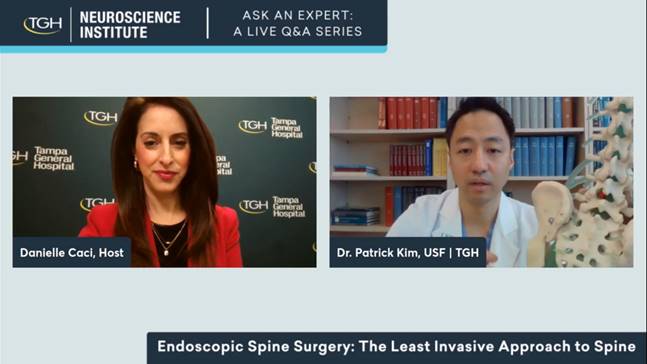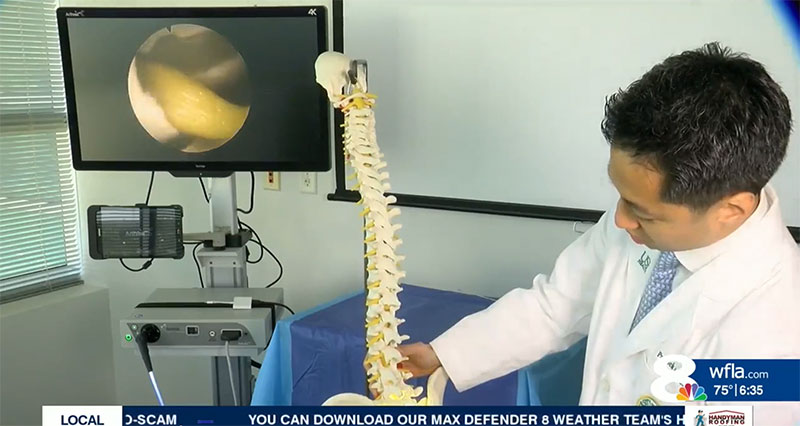Neurosurgery, Brain & Spine
Ultra Minimally Invasive Spine Surgery
What is Ultra Minimally Invasive Spine Surgery?
Ultra Minimally Invasive Spine Surgery, also known as Endoscopic Spine Surgery (ESS), stands as an innovative approach to spinal care, distinguishing itself from both Minimally Invasive Spine Surgery (MISS) and traditional open spine surgery through its utilization of cutting-edge techniques and equipment. While MISS employs tissue-sparing methods, often facilitated by specialized retractors, ESS takes this a step further by integrating endoscopic tools with a scope featuring a camera tip. This pivotal advancement results in notably smaller incisions and diminished tissue trauma compared to MISS. With superior visualization capabilities for surgeons and expedited recovery times for patients, ESS emerges as a transformative solution for a spectrum of spinal conditions, including herniated discs, spinal stenosis, and various degenerative spine ailments.
Spine Surgery in the News

Morning Blend with Dr. Patrick Kim
Tampa General Hospital Explains Who Makes a Good Candidate for Endoscopic Spine Surgery
Morning Blend with Dr. Patrick Kim

Day Time with Dr. Patrick Kim
Endoscopic Spine Surgery and Chronic Back Pain
Day Time with Dr. Patrick Kim

Facebook Live with Dr. Patrick Kim
Endoscopic Spine Surgery Q&A: The Least Invasive Approach to Spine
Facebook Live with Dr. Patrick Kim

Bloom Tampa Bay with Dr. Patrick Kim
Endoscopic Alternative for Patients Facing Spine Surgery
Bloom Tampa Bay with Dr. Patrick Kim
Benefits of Ultra Minimally Invasive Spine Surgery
The benefits of Ultra Minimally Invasive Spine Surgery, also known as Endoscopic Spine Surgery, include: minimized incision size, accelerated recovery time, alleviated postoperative pain, decreased infection rates, reduced blood loss, preservation of spinal stability, outpatient procedure or shortened hospital stay, versatility in treating different spinal conditions, enhanced visualization of the affected area, and enhanced cosmetic results. In conclusion, Endoscopic Spine Surgery represents a paradigm shift in spinal care, offering patients and surgeons alike a refined and less invasive alternative to Minimally Invasive and Traditional Spine Surgery.
Ultra Minimally Invasive Spine Surgery Entails
- Preoperative Evaluation: Comprehensive patient assessment, encompassing medical history, physical examination, and diagnostic imaging (MRI or CT scans), guides surgical planning.
- Anesthesia Administration: ESS is performed under either general anesthesia or local anesthesia with sedation, tailored to the specifics of the procedure and patient requirements.
- Incision and Access: Small incisions, typically less than a quarter of an inch, are made at the targeted area of the spine, aided by real-time X-ray guidance. A guide wire or dilator is introduced to establish a pathway to the affected spinal region.
- Endoscope Insertion: A tubular retractor is inserted through the dilated pathway, creating a channel to the spine. The endoscope, housing a camera and light source, is subsequently introduced through the tubular retractor.
- Visualization: The endoscope provides a magnified, illuminated view of the spinal structures on a monitor, facilitating real-time navigation and visualization of the surgical site.
- Treatment or Correction: Surgical instruments, such as probes, graspers, or shavers, are introduced through additional channels in the tubular retractor, enabling the performance of necessary procedures. This may include the removal of herniated discs, decompression of nerve roots, or stabilization of the spine.
- Closure: Following completion of the procedure, instruments are removed, and the small incision is closed, typically with skin glue.
- Recovery: Patients are monitored postoperatively, with many able to return home the same day, contingent upon the complexity of the procedure and individual patient factors. The minimally invasive nature of ESS often facilitates a swifter recovery compared to traditional open surgery.
- Postoperative Care: Patients receive comprehensive instructions for postoperative care, encompassing activity restrictions, medication management, and follow-up appointments as necessary.
Meet Our Expert

Patrick Kim, MD
Dr. Patrick Kim is a fellowship-trained neurosurgeon specializing in minimally invasive endoscopic spine surgery. He received his medical degree from LSU New Orleans and completed his residency at the University of Mississippi Medical Center. Subsequently, he pursued a fellowship in endoscopic spine surgery at University of Washington Harborview Medical Center.
As the region’s first fellowship-trained endoscopic spine surgeon, he is dedicated to introducing new techniques aimed at achieving quicker recovery and minimizing complications following spine surgery. He currently serves as an assistant professor within the Department of Neurosurgery, Brain and Spine, where he is passionately dedicated to educating and mentoring residents, actively contributing to the advancement of minimally invasive spine surgery. He shares his expertise and knowledge of endoscopic spine surgical techniques with fellow surgeons and serves as a reviewer for the World Neurosurgery Journal and the Journal of Minimally Invasive Spine Surgery and Techniques.